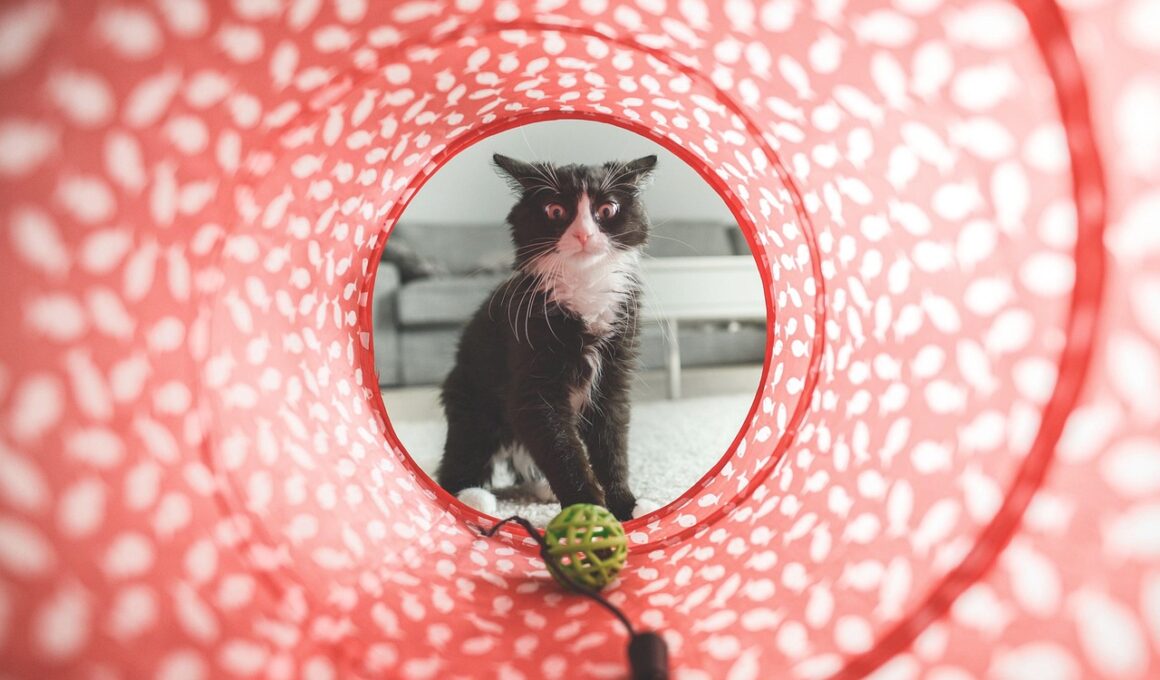Solo Play vs. Interactive Play: What Does Your Cat Prefer?
Cats are truly unique creatures, exhibiting a range of behaviors that reflect their personality, environment, and upbringing. One of the key aspects of a cat’s behavior is their play style, which can be categorized into two main types: solo play and interactive play. Solo play involves engaging with toys on their own, while interactive play relies on human involvement or other pets for stimulation. Understanding these play styles can enhance your relationship with your feline friend. Each cat has distinct preferences, and knowing these helps in providing them with an enriched environment. For instance, some cats thrive on the thrill of a feather toy waved in front of them, whereas others may prefer to chase a laser dot independently. Observing how your cat reacts during playtime can provide insights into their personality and needs. To keep your kitty engaged, consider rotating toys regularly, offering both types of play, and paying attention to which toys they show excitement towards. Ultimately, catering to your cat’s preferences can foster not only their happiness but also promote better mental health.
Engaging your cat in play is not just about entertainment; it serves various crucial functions. For cats, playing simulates hunting behaviors, allowing them to express their instincts in a safe environment. Furthermore, it helps them stay physically active, preventing obesity and related health issues. This is particularly important for indoor cats, who may not get the same level of exercise as their outdoor counterparts. Through play, cats can also relieve stress and anxiety. Recognizing which play style your cat prefers is essential in promoting overall well-being. For instance, cats who lean toward interactive play often bond more closely with their owners, as they enjoy the social interaction and mental stimulation. In contrast, those that prefer solo play might be more independent, needing alone time. It’s essential to respect each cat’s preferences and adapt play styles accordingly. Consider setting aside dedicated playtime that caters to both styles, allowing your feline companion to choose how to engage. This way, you can create a balanced play experience that satisfies their emotional and physical needs, enhancing their quality of life.
Identifying Play Styles
Identifying whether your cat prefers solo or interactive play can be an exciting exploration. Pay attention to how your cat interacts with different types of toys. For example, if your cat enjoys batting around balls of yarn or pouncing on crinkly toys without your involvement, they may prefer solo play. This can indicate a desire for independence, as they find joy in hunting and exploring on their own terms. On the other hand, if they jump excitedly at the sight of a string or laser pointer, they are likely more inclined towards interactive play. Additionally, some cats may enjoy both play styles, alternating between solo and interactive methods depending on their mood. Keep a variety of toys available that cater to both preferences. Provide toys that are designed for independent play, such as puzzle feeders or treat dispensers, to stimulate their problem-solving skills. Meanwhile, interactive toys like wand toys or laser pointers can bring you into the mix, enhancing communication and strengthening the bond you share. Observing your cat’s play behaviors can lead to the best outcomes for their happiness and well-being.
While your observations can provide valuable insights, it’s also essential to consider your cat’s history and personality. Factors such as age, breed, and even previous experiences can significantly impact how a cat approaches play. Younger cats tend to have higher energy levels and might prefer more interactive play sessions to burn off their excess energy. Older cats, however, may opt for slower-paced solo play, as it aligns with their need for relaxation and lower intensity. Additionally, certain breeds are known for their playful nature, such as Abyssinians or Bengals, who often thrive in interactive settings. By contrast, breeds like Persians may appreciate solo play activities that allow them to engage at their own pace. If you have adopted a cat from a shelter, their prior experiences could also dictate their play preferences. Cats that have had limited interaction with humans may initially shy away from interactive play. Gradually incorporating interactive sessions can help build trust and encourage them to enjoy social play in a safe context, ultimately enriching their life and yours.
Benefits of Both Play Styles
Embracing both solo and interactive play styles maximizes enrichment for your cat, allowing them to experience a diverse range of activities that keep them mentally stimulated. Engaging in solo play can help enhance their problem-solving skills and creativity. Puzzles or toys that require them to figure out how to access a treat can challenge their intelligence while satisfying their natural instincts. This kind of play is particularly beneficial for keeping their minds sharp, especially in aging cats who can suffer cognitive decline. Furthermore, solo play allows for self-discovery and independence that is vital for a well-rounded personality. On the flip side, interactive play provides vital emotional bonding with you, which strengthens the human-animal connection. Interactive play motivatesyour cat to be social, reducing anxiety and stress by encouraging them to participate in enjoyable activities together. Balancing both styles can lead to a happier, healthier cat, as you continuously engage their minds and satisfy their natural penchant for curiosity. Investing time in play is a valuable experience that brings joy to both you and your beloved companion.
Cats thrive in environments that promote stimulation—physically, mentally, and socially. To foster play preferences, you can create a stimulating environment filled with a variety of toys designed for both solo and interactive play. Providing scratching posts, climbing trees, and interactive feeders can help fulfill your cat’s natural curiosity and need for physical activity. Rotating toys on a regular basis keeps them feeling fresh and exciting, which can help maintain your cat’s interest over time. Additionally, consider scheduling regular interactive play sessions to create bonding experiences; this also promotes communication and affection between you and your cat. A good time to engage is during your cat’s most active hours, often early in the morning or late in the evening. Incorporate different types of interactive toys for variety, such as feather wands or beach balls, or even make your own with household items. During solo play, ensure your cat has safe toys they enjoy playing with independently. The blend of both play styles ensures that you are meeting their complex needs, leading to a delighted pet who feels loved and fulfilled.
Conclusion
In conclusion, understanding your cat’s play preferences plays an important role in enhancing their overall happiness and health. Recognizing the signs of whether your cat prefers solo or interactive play can improve your interactions and strengthen your bond. Cats are unique individuals; their play preferences can vary widely, influenced by temperament, breed, and past experiences. Offering both play styles not only satisfies their instinctual needs but also incorporates enrichment that keeps their minds active and engaged. By engaging in solo play alongside interactive sessions, you cater to both their independence and their social nature. Establishing a schedule that includes both styles can foster a stronger connection. Regularly observing your cat’s choices during play will help you customize your approach to their uniqueness, ensuring ample opportunity for exercise and enjoyment while building trust and affection between you both. Ultimately, the joy of seeing your cat engaged in play is not just a spectacle; it’s a rewarding experience that bonds you as companions, adding joy to both your lives. Make playtime a priority, and you will surely see the positive effects in your cat’s health and happiness.
As a closing note, investing in your cat’s play is also an investment in their emotional health, giving them a sense of security and joy. Observing their reactions and adapting your approach ensures you provide fun experiences that cater to their preferences, leading to a happier feline.


